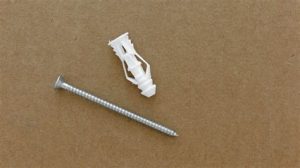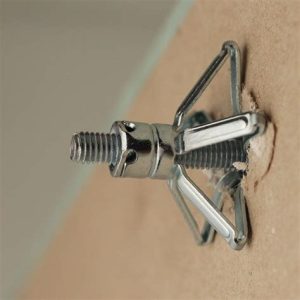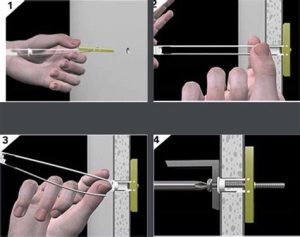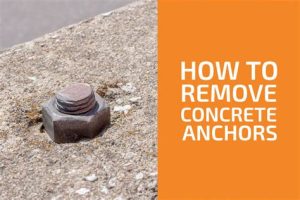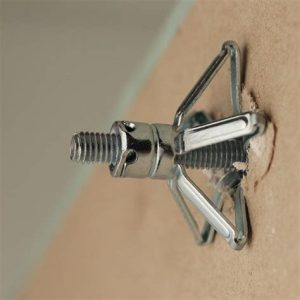Learn how to choose, install, and avoid mistakes with drywall anchors for secure mounting. Get tips and tools needed for successful installation.When it comes to hanging items on your walls, understanding how to properly use drywall anchors can make all the difference, especially when stud mounting isn’t an option. In this article, we’ll guide you through the essentials of using a drywall anchor without a stud, ensuring your items stay securely in place. We will delve into the types of drywall anchors available, help you choose the right one for your project, and provide a comprehensive step-by-step guide to successful installation. Additionally, we will highlight common pitfalls to avoid and answer frequently asked questions. Whether you’re a seasoned DIYer or a beginner looking to enhance your home decor, mastering the use of drywall anchors will empower you to tackle a variety of hanging projects with confidence. Let’s get started!
Understanding Drywall Anchors For Secure Mounting
Drywall anchors play a crucial role in securely mounting items to walls that don’t have studs behind them. These anchors provide the necessary support to hold heavy objects such as shelves, picture frames, or television mounts. When you ask, How do you use a drywall anchor with no stud? it’s essential to understand how these anchors distribute weight and prevent damage to your drywall.
There are several types of drywall anchors, including:
- Plastic expansion anchors: These are suitable for light-duty applications. They expand behind the drywall when the screw is inserted, providing moderate holding strength.
- Self-drilling metal anchors: Ideal for heavier loads, these anchors drill into the drywall without pre-drilling a hole. They are more robust than plastic anchors.
- Molly bolts: These anchors consist of a sleeve that expands against the back of the drywall, offering superior strength for supporting heavier objects.
- Toggle bolts: These are an excellent choice for heavy-duty applications. The toggle mechanism spreads the load on the backside of the drywall, making them exceptionally secure.
When using any drywall anchor, it’s important to follow the manufacturer’s weight ratings and installation instructions to ensure a safe and secure fit. Remember to factor in the weight of the item you intend to hang, as well as any additional stress it may experience, particularly with items that may be pulled or pushed. By choosing the right anchor for your needs, you’ll achieve a stable installation even without finding a stud.
How Do You Choose The Right Drywall Anchor?
Choosing the right drywall anchor is crucial for ensuring that your mounted items remain secure and do not damage the wall. Here are some key factors to consider when selecting a drywall anchor:
1. Weight Capacity
First and foremost, you need to determine the weight of the object you plan to hang. Different drywall anchors have varying weight limits, ranging from light-duty anchors that can hold about 10-25 pounds, to heavy-duty options that can support over 50 pounds. Ensure you select an anchor that matches or exceeds the weight requirement of your item.
2. Anchor Type
There are several types of drywall anchors, each designed for different applications:
- Plastic Expansion Anchors: Best for lightweight items, such as pictures and small shelves.
- Metal Toggle Bolts: Ideal for heavier items, providing more stability and a secure hold.
- Molly Bolts: These expand after insertion for added strength; suitable for medium to heavy items.
- Self-Drilling Anchors: Easy to install without pre-drilling, great for a variety of applications.
3. Wall Material Compatibility
Ensure that the anchor you choose is compatible with drywall specifically. Some anchors may work better in other materials, but for drywall, you need ones that expand or grip tightly within the wall space.
4. Depth of Installation
Consider how deep you need the anchor to go into the wall. Some anchors require a specific depth for stable installation. Review product specifications to pick one appropriate for your wall’s thickness.
5. Ease of Installation
If you are a DIY beginner, look for anchors that are easier to install, such as self-drilling anchors. These often come with user-friendly instructions and require minimal tools.
By evaluating these considerations, you can determine the right drywall anchor for your project and ensure a successful installation. Handling mounting correctly will not only enhance the aesthetic of your space but also provide lasting durability for your items.
Preparing The Wall: Tools And Materials Needed
When setting up to use a drywall anchor without a stud, it is essential to gather the right tools and materials to ensure a seamless installation process. Here’s a list of what you will need:
Tools
- Drill or screwdriver: Depending on the type of drywall anchor you are using, you may need either a drill or a manual screwdriver.
- Level: This tool will help ensure that your item is mounted straight.
- Tape measure: For accurate measurements when positioning your anchors.
- Pencil: To mark the spot where the anchor will be installed.
- Utility knife: In case you need to make any adjustments to the drywall.
Materials
- Drywall anchors: Choose the right anchors based on the weight of the item you need to hang.
- Screws: Ensure they are compatible with your chosen drywall anchors.
- Wall repair compound (optional): This may be needed if you’re patching any existing holes before installation.
Having these tools and materials on hand will set you up for success and help avoid common pitfalls, ensuring your installation goes smoothly. Proper preparation is key to achieving a secure and durable mounting solution.
Step-By-Step Guide To Installing A Drywall Anchor
Installing a drywall anchor without a stud can seem intimidating, but following a step-by-step approach can simplify the process. Here’s how to properly install a drywall anchor to ensure that your fixture is securely mounted:
Step 1: Gather Your Tools and Materials
Ensure you have all necessary tools, including:
- Drywall anchors
- Drill or screwdriver
- Drill bit (if necessary)
- Pencil for marking
- Tape measure
Step 2: Choose the Anchor Location
Identify where you want to install the anchor. Use a level to make sure the placement is even, especially if you’re hanging shelves or artwork.
Step 3: Mark the Spot
Once you’ve selected the location, mark the center of where the anchor will be installed using a pencil. This will serve as your guide for drilling.
Step 4: Drill a Hole (If Necessary)
If the drywall anchor requires a pilot hole, pick a drill bit that corresponds to the size of the anchor. Drill a hole at the marked spot to create a space for the anchor.
Step 5: Insert the Drywall Anchor
For plastic expansion anchors, push the anchor into the drilled hole until it’s flush with the wall surface. For toggle bolts or other types, follow the specific instructions provided with the anchor.
Step 6: Secure the Anchor
Using your screwdriver or drill, gently screw the anchor into place. Be careful not to overtighten, as this could damage the drywall.
Step 7: Attach Your Fixture
With the anchor securely in place, you can now mount your fixture. Align the fixture with the anchor and tighten it until it is firmly attached to the wall.
Step 8: Test the Installation
Carefully test the fixture’s stability by applying gentle pressure to ensure that it holds. If everything feels secure, your drywall anchor installation is complete!
This straightforward process ensures that even with no studs behind the drywall, your fixtures will be safely supported. Remember to always refer to the manufacturer’s instructions for specific anchor types and their installation procedures.
Common Mistakes To Avoid When Using Drywall Anchors
Using drywall anchors without a stud can be a daunting task, and making mistakes can lead to unsatisfactory results. Here are some common pitfalls to watch out for:
1. Choosing the Wrong Type of Anchor
Different applications require different types of anchors. Ensure that the chosen anchor is suitable for the weight of the object you plan to hang. For heavier items, prefer using toggle bolts or metal anchors for better support.
2. Not Drilling a Proper Hole
One of the most common mistakes is drilling a hole that is either too small or too large. Always refer to the manufacturer’s guidelines for the appropriate size drill bit to avoid compromising the anchor’s grip.
3. Over-tightening the Screw
Over-tightening can cause the drywall to crack or the anchor to break loose. Be gentle when securing the screw; snug is often enough.
4. Ignoring Wall Thickness
Not considering the thickness of your drywall can lead to anchors that do not fit properly. Ensure your anchor is designed for the thickness of your wall materials.
5. Installing Anchors in Compromised Drywall
Never place anchors in areas where the drywall is damaged or weakened. Repair any compromised areas before attempting to mount anything.
6. Misplacing the Anchor
Improper placement of the anchor can affect the balance and stability of the mounted object. Measure carefully before drilling to ensure the anchor is positioned accurately.
7. Not Testing the Anchor Strength
After installation, gently test the anchor’s strength before hanging your item. This ensures it can handle the weight without any issues.
8. Failing to Plan for Load Distribution
If you’re hanging a large item, consider using multiple anchors to distribute weight evenly across the wall to prevent one anchor from taking the brunt of the load.
9. Overlooking Wall Material
Different walls (like plaster, cement board, or drywall) require specific types of anchors. Be sure to choose the appropriate one based on your wall type.
10. Not Following Manufacturer Instructions
Every drywall anchor comes with instructions. Failing to read and follow these can lead to improper installation and potential failure of the anchor.
By avoiding these common mistakes, you can ensure a successful installation of drywall anchors and achieve a secure, reliable hold for your mounted items.
Frequently Asked Questions
What is a drywall anchor?
A drywall anchor is a fastener used to attach objects to drywall without relying on a stud for support. It helps distribute the weight of the item being hung.
Why would I need to use a drywall anchor without a stud?
Using a drywall anchor without a stud is necessary when you want to hang items in areas where studs are not available, such as in between studs or on a hollow wall.
What types of drywall anchors can I use without a stud?
Common types of drywall anchors that can be used without a stud include toggle bolts, molly bolts, and plastic expansion anchors.
How do I install a drywall anchor?
To install a drywall anchor, first, use a drill or a nail to create a pilot hole, then insert the anchor and, if necessary, tighten the screw into the anchor to secure it to the wall.
How much weight can a drywall anchor support?
The weight capacity of a drywall anchor varies by type. Light-duty anchors can hold up to 20 pounds, while heavy-duty anchors can support 50 pounds or more depending on the installation.
Are there any risks to using drywall anchors?
Yes, if a drywall anchor is not properly installed or if it exceeds its weight limit, it can pull out of the wall, leading to damage or the object falling.
Can I remove a drywall anchor after installation?
Yes, drywall anchors can be removed, though some types may leave a hole in the wall that may need to be patched.
